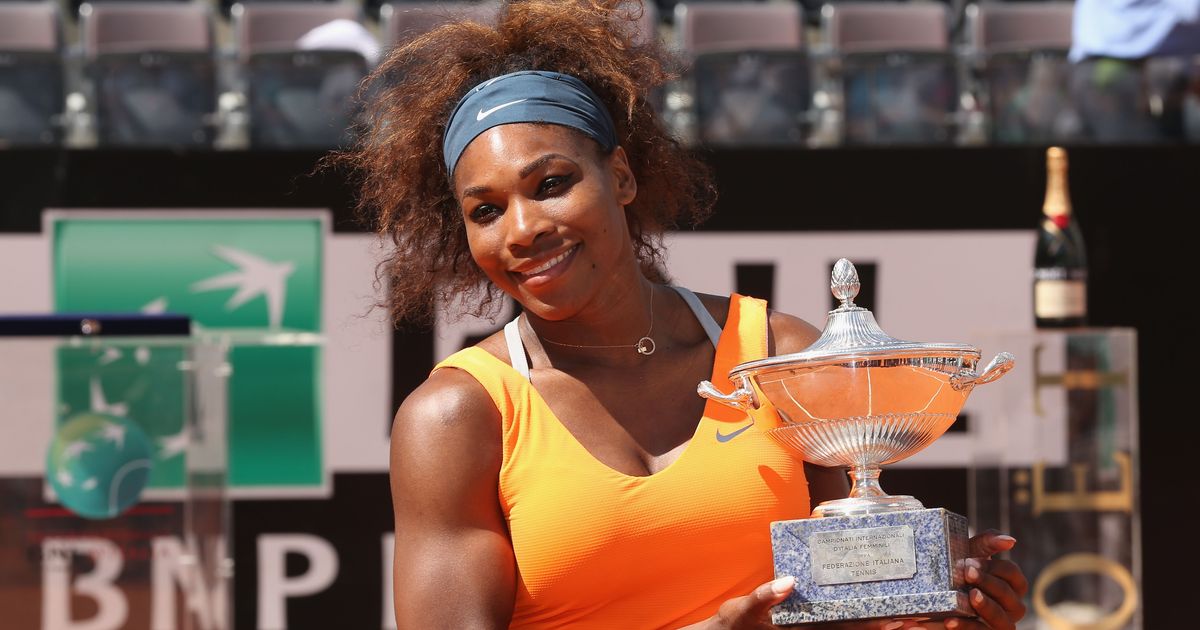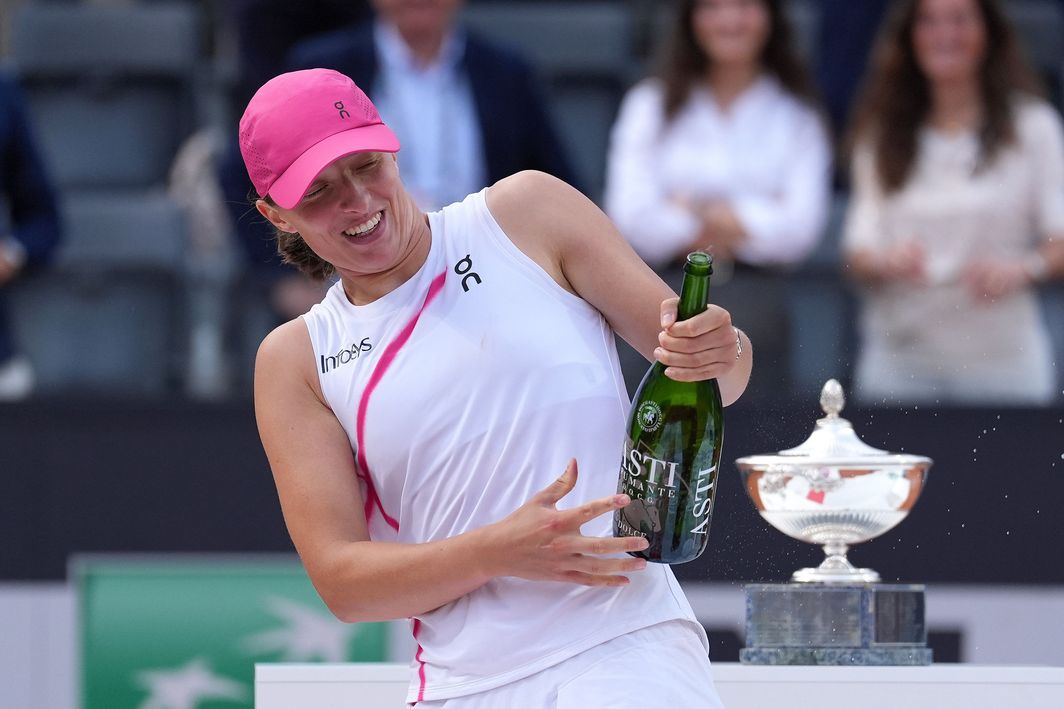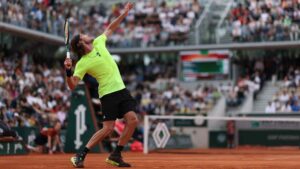
Not two hours had passed since Aryna Sabalenka’s historic win in Madrid, when reporters were already dragging her into the future.
“Three Madrid titles,” one began on Saturday, “the way you’re playing, in your mind, can you win in Rome or Paris for the first time?”
Sabalenka, exhausted, had the good grace to laugh.
“I mean, in my mind, in my dreams, yes I can,” she said. “But sometimes the reality is different. I will definitely go out there and compete and fight and see if my dream will be the same in real life.”
She came close a year ago, knocking off Top 20 players Elina Svitolina, Jelena Ostapenko and Danielle Collins on the way to the final. But Iga Swiatek was better at that ultimate stage, executing a virtually flawless 6-2, 6-3 victory.
That gave Swiatek rare back-to-back titles in Madrid and Rome — let’s call it the Red-Dirt Double. And now, Sabalenka, who lost in both those finals, has an opportunity to do it herself.
She could join Dinara Safina, Serena Williams and Swiatek as the only women to pull it off.
Here are their stories:
Dinara Safina 2009
Her first tournament as the WTA Tour’s No. 1-ranked player came that year in Stuttgart. And while Safina lost to archrival Svetlana Kuznetsova in the straight-sets final, she was about to set off on a 16-match winning streak, the most significant of her career.
Safina, then 23, was a powerful, strapping player, but had an unusual affinity for clay.
“To be honest, I loved that surface,” she told wtatennis.com in Madrid. “I knew that some of my biggest opponents, like Serena [Williams]it was not their best surface. I felt like on clay I have more chances to beat them because it’s slower than grass or hard courts. That’s why it was giving me more confidence.”
Training predominantly in Valencia, Spain she would finish her career with a 101-38 (.727) record on clay, by far her best surface. Unlike today, the Italian Open was then played before Madrid and Safina progressed to the semifinals where No. 4 seed Venus Williams awaited.
Safin dropped a first-set tiebreak but came back to win 6-7 (3), 6-3, 6-4.
“The only one time I won against her — the rest I was picking up the balls,” Safina said. “That one was pretty nice, but the same year at Wimbledon I lost 6-1, 6-love.”
Safina was a breezy 6-3, 6-2 winner in the Rome final against Kuznetsova — she had only 15 unforced errors, half of Kuznetsova’s total — and collected $350,000.
“I had in my head that I had lost three finals this year,” Safina said at the time. “I was like, ‘I don’t want to have this that I’m losing finals.’”
And then it was time to transition to appreciably faster courts in Madrid.
“The most difficult thing is the concentration through the whole period,” Safina said. “After winning the tournament [Rome]you go to the next and you are very excited. And then it’s like, `OK, you have to come back down to earth — back to work. Back to … to suffer.’”
Safina dropped only one set on the way to the final (to Lucie Safarova in the Round of 16) and had another easy time there, defeating Caroline Wozniacki 6-2, 6-4.
“Serena lost early, so it was pretty open the draw,” Safina said. “And I had a pretty good draw to take my chances.
“I came in very confident, playing good at the time. I was very happy to win that one.”
At Roland Garros, Safina dropped only five games in advancing to the quarterfinals but saw her 16-match win streak ended by Kuznetsova in the final.
Serena Williams 2013
The year before, she had won in Madrid on the one-time experiment of blue clay. By 2013, however, order was restored and the courts had returned to their burnt-sienna luster.
This was peak Serena, in the midst of her greatest season by virtually every measure. She had already won in Brisbane, Miami and Charleston — and would go on to take 12 titles and produce a record of 78-5 (.940).
Madrid was typical of her runs through the draws; her only dropped set in six matches was to wildcard Anabel Medina Garrigues. She reached the final opposite No. 2 seed Maria Sharapova with the No. 1 ranking on the line.
This appeared to be Sharapova’s best chance to beat Serena for the first time in eight years. She had not dropped a set in the tournament and was on a searing 25-match winning streak on red clay. Meanwhile, it was Williams’ first red-clay final in more than a decade.
And yet … Williams handled Sharapova 6-1, 6-4 in that anticlimactic final. It took only 75 minutes and was her 50th career singles title — her first on red clay since the 2002 French Open.
Afterward, Serena walked into a press conference wearing a red t-shirt with the phrase “Bestest Ever.”
Smiling, she said, “Every time I play, I really relish it more. I feel like, honestly, Serena, when are you going to get tired? I don’t know.”
And then Rome pretty much the same way. Losing only 10 games in her first four matches, Williams hammered Simona Halep in the semifinals, setting up a final matchup with No. 3-ranked Victoria Azarenka. Azarenka, the two-time reigning Australian Open champion, was ranked No. 1 for most of the previous year and had won their most recent meeting in Doha.
The final was 6-1, 6-3, and it was Williams’ 24th straight match win — and her 16th straight on clay. In her speech at the trophy presentation, she spoke fairly fluent Italian.
She would go on to add seven victories to each of those totals in the coming fortnight in Paris. Williams defeated Sharapova 6-4, 6-4 in the final for her second of three titles at Roland Garros.
Iga Swiatek 2024
“It’s hard to relive it,” Swiatek said of the 2024 Madrid final, “because there are not many matches that are so intense and on such a high level. Sometimes the finals are actually a bit worse level than quarterfinals or semis, because the players are a little bit tight.
“But me and Aryna, we put on a great show, for sure. I just thought that because, you know, also for the fans I think it was great to watch it.”
Great might have been an understatement. Swiatek’s 7-5, 4-6, 7-6 (7) win over Aryna Sabalenka was, in many minds, the best match of the year. Not only did Swiatek avenge her loss in the 2023 Madrid final, but she saved three match points in the process.
The match required 3 hours and 11 minutes and wound up as the year’s longest final.
“That match was, yeah, it was a ball-buster,” Sabalenka said before this year’s tournament in Madrid. “That was amazing match, even though I lost it. This is like nothing I can be upset with, to be honest. I did my best there, and she just outplayed me.”
The slower surface in Rome played more to Swiatek’s strengths. This time, she was a 6-2, 6-3 winner over Sabalenka in the Internazionali BNL d’Italia final. It was Swiatek’s third Rome title in four years — and the eighth over Sabalenka in 11 meetings.
Moreover, it was Swiatek’s eighth consecutive win in a championship final.
“I kind of knew that if I’m going to work hard and if I’m going to be in the right mindset, this is achievable,” Swiatek told reporters. “I’m happy I was so focused and disciplined throughout the tournament to do that.”
Rome joined Roland Garros and Doha as tournaments where Swiatek was a three-time champion.
“For sure this match looked a little bit differently than in Madrid,” Swiatek said. “I felt like I’m putting a lot of pressure. I just continued doing that throughout the whole match. Really proud of myself and really happy.”
Source: https://www.wtatennis.com/news/4259270/looking-back-at-the-rare-red-dirt-double-and-whether-sabalenka-could-be-next




